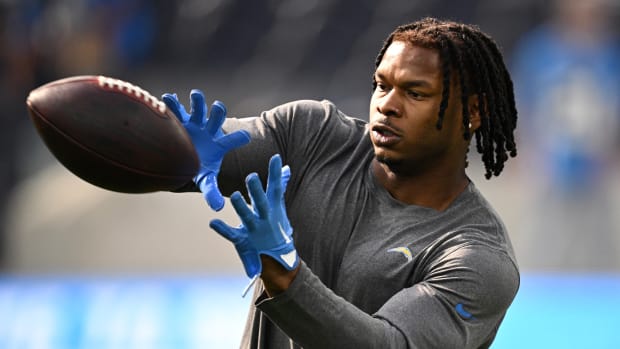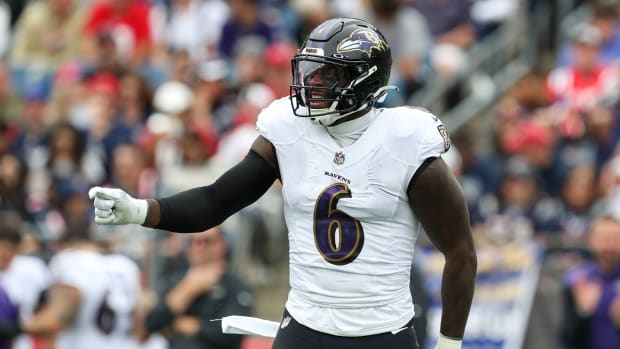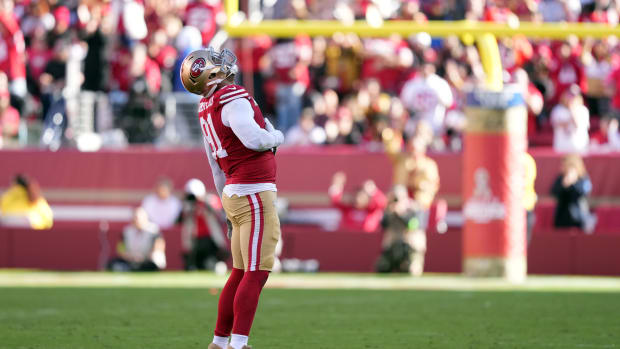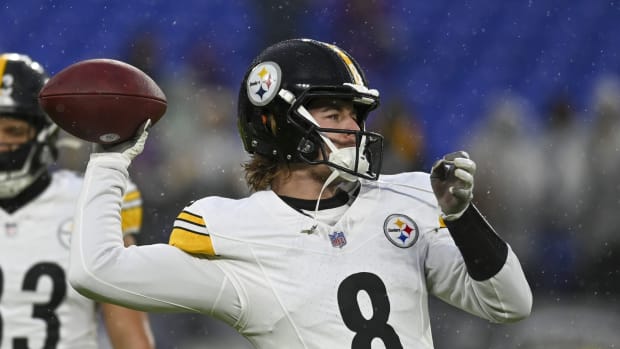It’s Complicated
Trent Richardson has not been the explosive playmaker the previous Cleveland regime was hoping for when it dealt four draft picks to move up one spot and take him at No. 3 in 2012.
This is close. The Colts didn’t win the Trent Richardson trade in a slam dunk by dealing a 2014 first-round draft choice for him, and the Browns didn’t cream the Colts in the deal. It’s … well, complicated.
A word about the Browns first. On draft day 2012 they traded up one spot in the first round to draft Richardson, the Alabama running back, third overall. To make the move, Cleveland gave the Vikings first-, fourth-, fifth- and seventh-round picks. Richardson played 17 games for the Browns and, at 23, was traded to Indianapolis for a first-round pick in 2014. So, this back who was worth four picks and got chosen near the top of the 2012 draft—and who isn’t hurt—suddenly is worth a pick likely somewhere in the middle of the 2014 first round. Amazing how much the new regime in Cleveland has devalued Richardson in the span of a year. Plus, how does a team tell its players with 14 games left in the season that they’re playing for 2014? I’ve heard of teams throwing in the towel in mid-November. Mid-September? Unheard of. But the Browns have now stockpiled high picks (seven in the first four rounds next May) to be in position to pick a top quarterback, so it’s understandable from their point of view.
But I think the Colts got the better of the deal. They’ve fortified a need position on a playoff contender with a player who is better than he’s played in his 17 NFL games. When you have Andrew Luck, every year is a year to contend deep into January. New offensive coordinator Pep Hamilton wants to be able to use a power running game, and the Colts lost their top back, Vick Ballard, to an ACL tear last week.
Lots of good teams have gaping needs right now. How many actually risk this much to do something about it?
“I know the risk,” GM Ryan Grigson told me late Wednesday night. “I watched every game [Richardson] played for Cleveland. Believe me, I know the numbers—3.5 yards a carry, long [run] of 32—but I also know in this business you can go by the norm, and you can go by the eye test. What do your eyes tell you? They tell me he’s special. He’s a 4.48-second 40 guy who defenders don’t want to tackle. I loved this kid coming out. He’s only 23 years old, and I still think he’s a great back.’’
Trent Richardson talking to Jim Brown at training camp this year. (John DePetro/SI)
Grigson would do this. John Schneider, in Seattle, would do this. Thomas Dimitroff, in Atlanta, would do this. Not many other GMs would. Maybe none. There’s no insurance for moves like this, but I believe Grigson will be proven right. He trusts his ability as a scout to make up for the loss of a first-round pick—particularly when he gets a young, salary-controlled, above-average starter at a big need position for $6.65 million for the next three seasons.
I want my general manager to have the courage of his convictions to make a deal like this one. I want my coach to know he’s got a GM who’s not going to wait until draft day to fix a big problem. I want my players to think, “The front office is doing everything it can do to win now.” And that’s the case in Indianapolis now. How do you think Robert Mathis and Reggie Wayne, who might be in their last season or two, feel about their team this morning? Pretty good, I bet.
Running backs have become devalued in the last few years, with good reason. You can find good ones down the line and as undrafted free agents. Trent Richardson has been just a guy for Cleveland. Had he been great early as a Brown, CEO Joe Banner never would have traded him. But he hasn’t been great. Grigson’s eyes tell him Richardson can be great, and will be great in the right environment. That environment includes a quarterback, Luck, who will make sure defenses aren’t laser-focused on stopping Richardson, the way they were when teams played the Brandon Weeden-piloted Browns
Last year I remember hearing Mike Mayock call Richardson the best back to enter the draft since Adrian Peterson in 2007. Seventeen games is not enough to judge Richardson a washout. The Colts did the right thing, because when Luck is the quarterback, the future is always now.
[si_video id="video_E9D6DAEC-4166-074F-EDA2-37640B322236"]
You’re Wrong, Peter: It’s a Clear Browns Win
A SECOND OPINION, BY ROBERT KLEMKO
It was the only move.
If you’re Browns president Joe Banner and GM Mike Lombardi, you weren’t around when the team drafted a running back with the third overall selection a year ago, but you were willing to give the kid a chance. You found out quickly that this was not the kind of running back who creates extra yards when there are none to be had. You had a solid, somewhat dependable running back—a guy with a history of ankle injuries and a knee that needed to be scoped the summer he was signed—a guy who told me three weeks ago that he sometimes thinks about making the safe play and preserving his health and longevity by going down or scooting out of bounds, but then he wants “that one extra inch.”
Andre Johnson was a No. 3 pick. So were Larry Fitzgerald and Matt Ryan. You were hoping he’d show the potential to be as good as them, or maybe a transcendent talent, an Adrian Peterson. The kind of player who makes it justifiable to draft a running back in the top 10 in a league ever-trending toward the passing game.
But Richardson wasn’t that. He gained 950 yards on a measly 3.6 yards per attempt as a rookie. He could catch, sure, but he struggled in pass protection, and his work ethic, well, it wasn’t Petersonesque. So you were willing to trade him; to cut your losses and move on. And then somebody (the Colts) offered a first-round pick for him. It’s not throwing in the towel on the season to take the deal. It’s an affirmation of what we already know: Quarterback play and defense win games in the NFL, not running backs who miss cutback lanes and do just enough to chalk up 60 yards on Sunday.
It was the only move for the Browns, and it should have never come to this.
For the Browns, the Trent Richardson trade was all about positioning the team to take a franchise-maker such as Louisville quarterback Teddy Bridgewater and get in step with today’s game. (David E. Klutho/SI)
Take a look at the top five rushers in the NFL last season after Peterson, who was drafted seventh overall because of durability concerns coming out of Oklahoma. (Ha!). They were Alfred Morris, Marshawn Lynch, Jamaal Charles, Doug Martin and Arian Foster, drafted, respectively, in rounds 6, 1, 3, 1 and not at all. Morris was considered too slow, Charles too weak, and Foster flat out no good. Discounting the extremes (Peterson and Foster), the top six NFL backs in 2012 were chosen, on average, 72nd overall. So you know you can find a capable rusher in the later rounds. First you need a quarterback and a franchise tackle and an edge rusher.
Now you can make amends for a franchise’s failings. At your disposal: two first-round picks in 2014 and 10 overall selections. You have the ammunition to deal for the No. 1 overall selection to snag Louisville QB Teddy Bridgewater and not suffer in the later rounds. Or you have the luxury of choosing with your first selection a sure thing like South Carolina defensive end Jadeveon Clowney or Michigan offensive tackle Taylor Lewan and waiting until the mid- to late first round for a quarterback in a class bulging with them (A.J. McCarron, Johnny Manziel, Tajh Boyd, Braxton Miller). Or you can select a quarterback with your top-five pick and take a pass-catcher with the second choice.
Better that than finishing just better than Jacksonville, trading everything for the right to draft Bridgewater at No. 1, and surrounding him with nothing but an injury-prone running back, a mediocre offensive line and an inexperienced receiving corps. Now you have options, unlike the Colts, who have bet their immediate future on a guy you weren’t sure about—a running back built for power in a league yielding to finesse.
Maybe Richardson works out for Indianapolis. Maybe the Colts run power successfully as a means of protecting franchise quarterback Andrew Luck, and maybe Richardson benefits from having a bona fide passer in the backfield as opposed to Brandon Weeden or Jason Campbell or Brian Hoyer. Or maybe they regret it when Richardson isn’t the back they envisioned and Reggie Wayne retires and they could have used that No. 1 pick on Luck’s next great wide receiver.








































